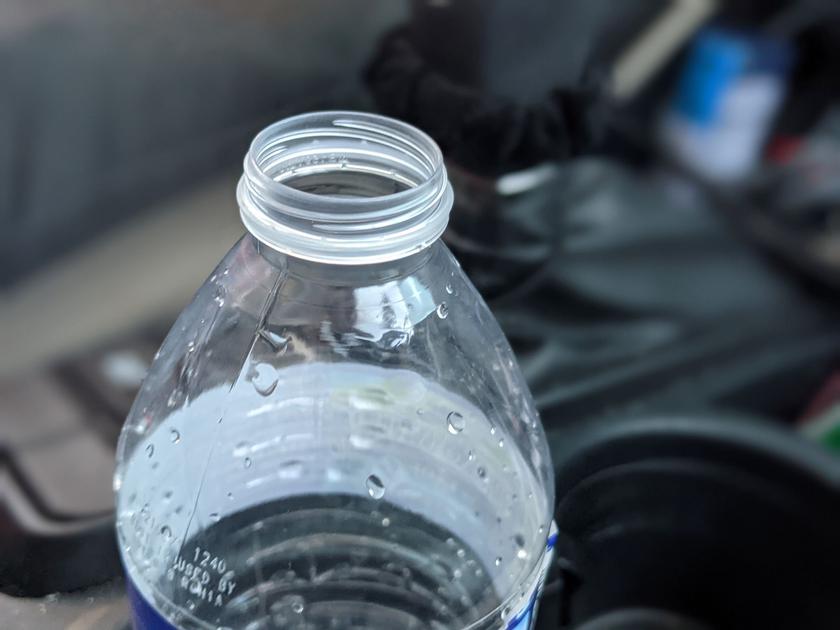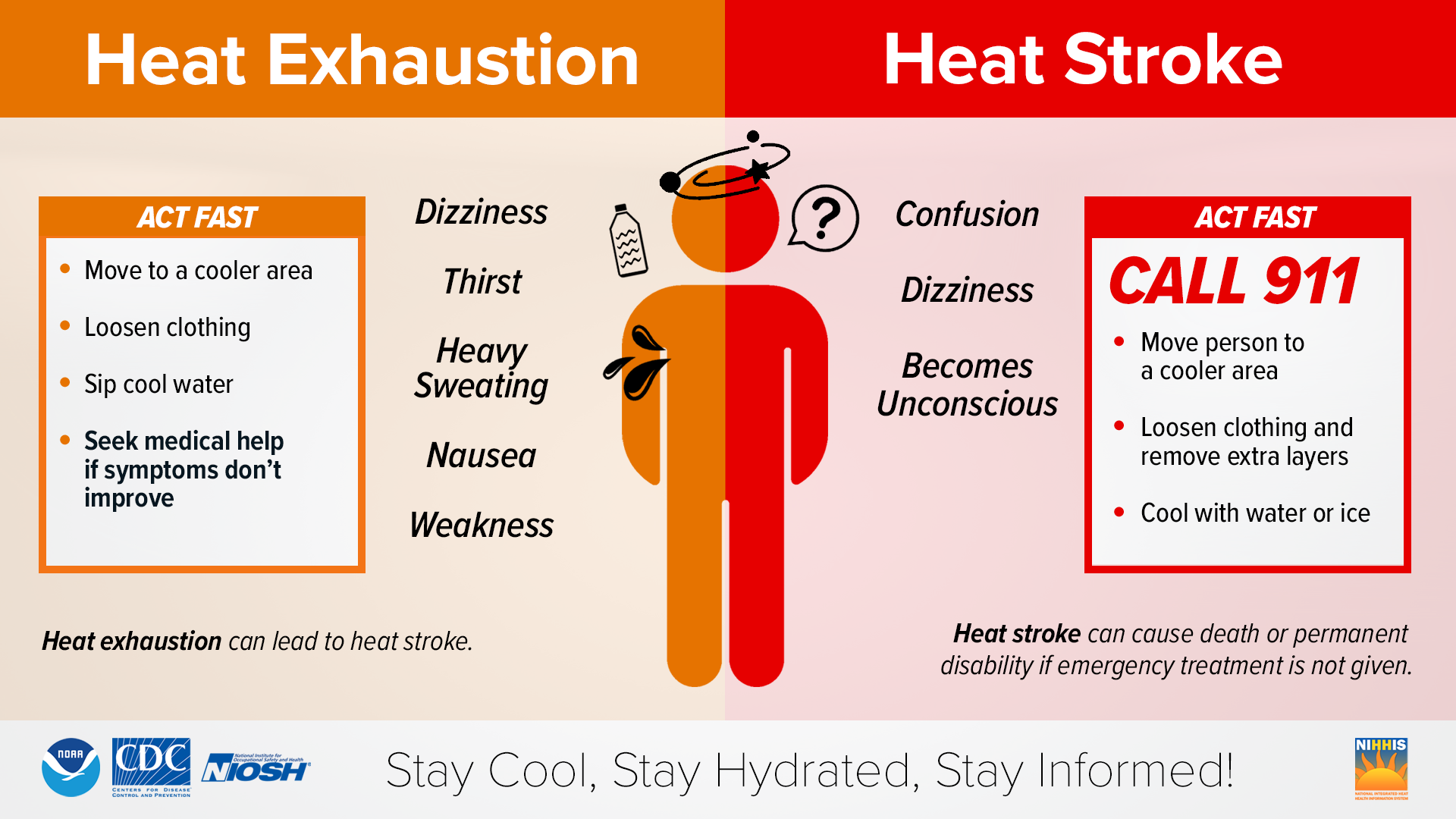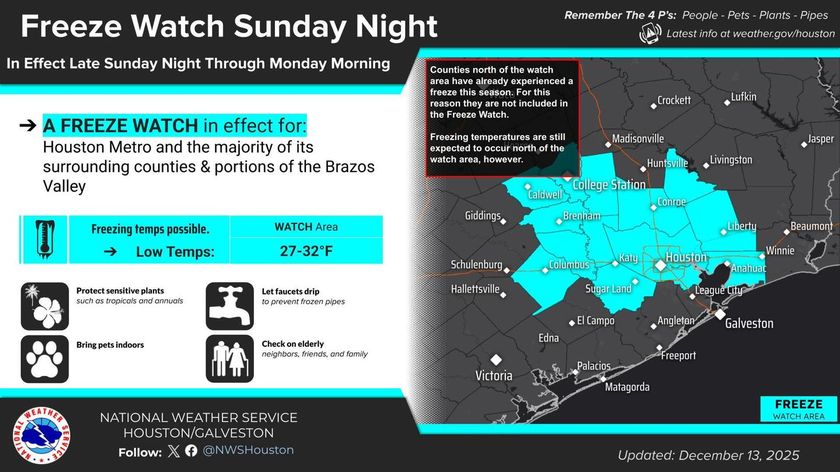- Sections :
- Crime & Public Safety
- Restaurants & Food
- Sports
- More
Categories
Know the warning signs – Heat exhaustion vs heat stroke
THE WOODLANDS, TX – Even before summer officially started earlier this week, the temperatures have been steadily moving upwards through the mercury markers, and we broke the 100-degree mark unseasonably early.
Adding to the dry heat is a significant humidity factor, which can up the ‘feels like’ temperature as much as fifteen degrees or more. The recent storms certainly didn’t help keep the air dry, and we have officially crept into dangerous heat conditions.
In hot, humid weather such as this, the body’s ability to cool itself is hard-pressed to function properly. Sometimes this is due to the body heat increasing too quickly, sometimes when essential fluids and salt content are lost through sweating or lack of water intake. Add to that the sheer onslaught on the system that naked exposure to the blazing sun can cause, and unwary people can find themselves in trouble and quick.
According to the CDC, there are three levels of heat-related maladies to keep an eye out on, along with a list of their symptoms: heat cramps, heat exhaustion, and heat stroke. It’s vital to know the warning signs of each and how to overcome them should you or someone you know fall victim to them.
Heat Cramps
These are typically the first sign of a heat-centric illness. Heat cramps usually start off as painful muscle cramps and spasms in the legs and possibly abdomen. Frequently they’re accompanied by heavy sweating. At the first sign of such cramps. You are encouraged to massage the affected areas and maintain a firm pressure. Drink water in small but regular sips, unless you start to feel nauseous, in which case stop drinking and find medical attention. Also seek attention if the cramps last more than an hour.
Heat Exhaustion
This second level of heat-related illnesses may not always follow cramping, and is oftentimes the first sign of trouble. It also doesn’t take long to start suffering the effects of heat exhaustion, and it’s easy to lose track of time and water intake while you’re enjoying yourself outdoors. Symptoms of heat exhaustion include heavy sweating, skin that’s cool and / or clammy to the touch, a paleness to the complexion, sudden tiredness and weakness, muscle cramps, a weak pulse, dizziness, and nausea and / or vomiting.
First Aid, swiftly administered, is essential to combating heat exhaustion. Immediately move yourself – or the person exhibiting symptoms if applicable – to shelter, preferably air conditioned. Loosen as much clothing as practical. Wet some cloths with cool water and apply it to the head, neck, underarms, groin, and elsewhere as needed. If possible, sit in a cool bath. Drink water in sips, allowing plenty of time in between for it to settle. If you or the sufferer vomit more than once, or if the symptoms don’t abate after an hour, it is vital to immediately seek medical attention.
Heat Stroke
This is the third, final, and most dangerous of heat-related illnesses. Heat stroke can manifest itself without either of the preceding maladies and can seemingly spring up from out of nowhere. Symptoms can include a throbbing headache; confusion; nausea; dizziness; skin that can be hot, red, dry, or damp; rapid and strong pulse; fainting; loss of consciousness, and a body temperature above 103°F.
At the very first sign of heat stroke, call 911 or get yourself – or the victim – to the nearest medical center. Do not hesitate; the slightest delay could be fatal. If at all possible, get yourself or the victim inside a cooler, preferably air-conditioned, environment. Apply cool, wet cloths in the same way as you would treating heat exhaustion; if possible, bathe or hose down with cool water. Most importantly as you wait for medical treatment, do not give or take in any fluids.
No matter which of the maladies may be involved, it’s important to note that using a fan in an attempt to cool yourself down when the heat index temperature is in the upper 90s could actually do more harm than good. A fan can make you hotter at higher temperatures. Naturally, if you’re indoors with a ceiling fan, you can rest easy.
Speaking of ceiling fans, you may not be aware that most of them have dual modes: one for winter and one for summer. During the summer, you want the blades to spin counterclockwise; this will push cool air down into the main room; winter mode reverses this, with the clockwise-spinning blades drawing the air into an updraft to circulate warmer air. So, for the next several months at least, ensure your ceiling fans are spinning counterclockwise; if not, look for a simple switch on the main unit.
By following these simple tips, you can significantly increase your chances of staying cooler – and safer – during these hot summer months.
Adding to the dry heat is a significant humidity factor, which can up the ‘feels like’ temperature as much as fifteen degrees or more. The recent storms certainly didn’t help keep the air dry, and we have officially crept into dangerous heat conditions.
In hot, humid weather such as this, the body’s ability to cool itself is hard-pressed to function properly. Sometimes this is due to the body heat increasing too quickly, sometimes when essential fluids and salt content are lost through sweating or lack of water intake. Add to that the sheer onslaught on the system that naked exposure to the blazing sun can cause, and unwary people can find themselves in trouble and quick.
According to the CDC, there are three levels of heat-related maladies to keep an eye out on, along with a list of their symptoms: heat cramps, heat exhaustion, and heat stroke. It’s vital to know the warning signs of each and how to overcome them should you or someone you know fall victim to them.
Heat Cramps
These are typically the first sign of a heat-centric illness. Heat cramps usually start off as painful muscle cramps and spasms in the legs and possibly abdomen. Frequently they’re accompanied by heavy sweating. At the first sign of such cramps. You are encouraged to massage the affected areas and maintain a firm pressure. Drink water in small but regular sips, unless you start to feel nauseous, in which case stop drinking and find medical attention. Also seek attention if the cramps last more than an hour.
Heat Exhaustion
This second level of heat-related illnesses may not always follow cramping, and is oftentimes the first sign of trouble. It also doesn’t take long to start suffering the effects of heat exhaustion, and it’s easy to lose track of time and water intake while you’re enjoying yourself outdoors. Symptoms of heat exhaustion include heavy sweating, skin that’s cool and / or clammy to the touch, a paleness to the complexion, sudden tiredness and weakness, muscle cramps, a weak pulse, dizziness, and nausea and / or vomiting.
First Aid, swiftly administered, is essential to combating heat exhaustion. Immediately move yourself – or the person exhibiting symptoms if applicable – to shelter, preferably air conditioned. Loosen as much clothing as practical. Wet some cloths with cool water and apply it to the head, neck, underarms, groin, and elsewhere as needed. If possible, sit in a cool bath. Drink water in sips, allowing plenty of time in between for it to settle. If you or the sufferer vomit more than once, or if the symptoms don’t abate after an hour, it is vital to immediately seek medical attention.
Heat Stroke
This is the third, final, and most dangerous of heat-related illnesses. Heat stroke can manifest itself without either of the preceding maladies and can seemingly spring up from out of nowhere. Symptoms can include a throbbing headache; confusion; nausea; dizziness; skin that can be hot, red, dry, or damp; rapid and strong pulse; fainting; loss of consciousness, and a body temperature above 103°F.
At the very first sign of heat stroke, call 911 or get yourself – or the victim – to the nearest medical center. Do not hesitate; the slightest delay could be fatal. If at all possible, get yourself or the victim inside a cooler, preferably air-conditioned, environment. Apply cool, wet cloths in the same way as you would treating heat exhaustion; if possible, bathe or hose down with cool water. Most importantly as you wait for medical treatment, do not give or take in any fluids.
No matter which of the maladies may be involved, it’s important to note that using a fan in an attempt to cool yourself down when the heat index temperature is in the upper 90s could actually do more harm than good. A fan can make you hotter at higher temperatures. Naturally, if you’re indoors with a ceiling fan, you can rest easy.
Speaking of ceiling fans, you may not be aware that most of them have dual modes: one for winter and one for summer. During the summer, you want the blades to spin counterclockwise; this will push cool air down into the main room; winter mode reverses this, with the clockwise-spinning blades drawing the air into an updraft to circulate warmer air. So, for the next several months at least, ensure your ceiling fans are spinning counterclockwise; if not, look for a simple switch on the main unit.
By following these simple tips, you can significantly increase your chances of staying cooler – and safer – during these hot summer months.
Comments •























